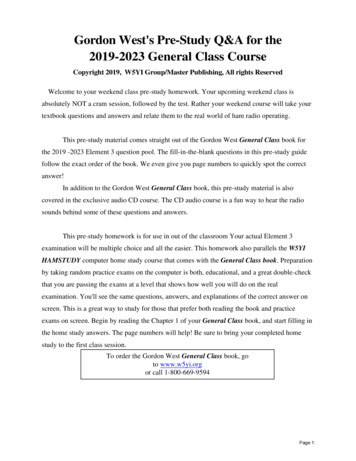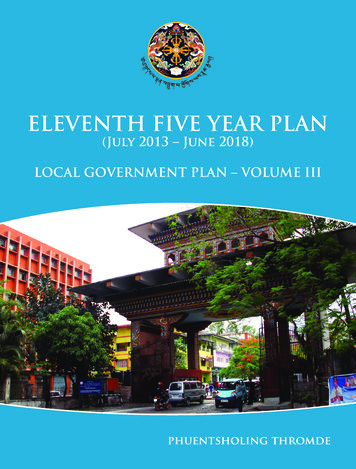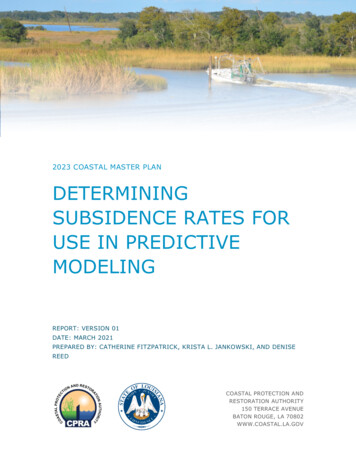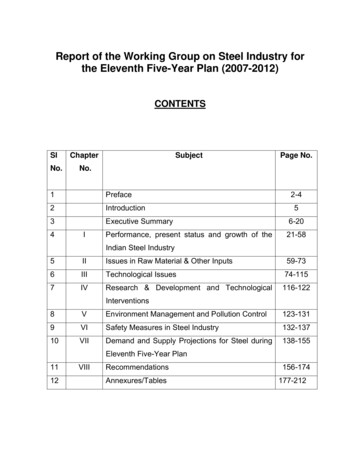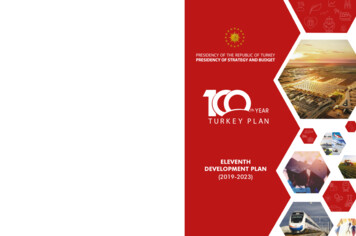
Transcription
DECISIONOFTHE GRAND NATIONAL ASSEMBLY OF TURKEYDecision on the approval ofthe Eleventh Development Plan (2019-2023)Decision No. 1225Decision Date: 18 July 2019The Eleventh Development Plan (2019-2023) was approved in the 105th plenarysession of The Grand National Assembly of Turkey on 18.07.2019, in accordancewith the provision of the Law No. 3067, dated 30.10.1984.
The Eleventh Development Plan (2019-2023) has been prepared in Turkish. This istranslation of the original document.
CONTENTSTABLES.viABBREVIATIONS.viiiCHAPTER ONE1. INTRODUCTION.12. GLOBAL DEVELOPMENTS AND TRENDS.52.1. GLOBAL TRENDS AND INTERACTIONS WITH TURKEY.52.2. GLOBAL MACROECONOMIC DEVELOPMENTS AND PROSPECTS.153. PRE-PLAN PERIOD ECONOMIC AND SOCIAL DEVELOPMENTS IN TURKEY.19CHAPTER TWO1. VISION, MAIN OBJECTIVES AND PRINCPLES OF THE ELEVENTH DEVELOPMENT PLAN.292. OBJECTIVES AND POLICIES OF THE PLAN.312.1. STABLE AND STRONG ECONOMY.312.1.1. Macroeconomic Policy Framework.332.1.2. Domestic Savings.392.1.3. Balance of Payments.402.1.4. Inflation and Monetary Policy.442.1.5. Financial Sector.452.1.6. Fiscal Policy.492.1.7. Social Security System and Finance.532.1.8. Public Enterprises and Privatization.542.2. COMPETITIVE PRODUCTION AND PRODUCTIVITY.572.2.1. Industrial Policies.612.2.1.1. Horizontal Policy Areas.612.2.1.1.1. Strong Financial Structure.612.2.1.1.2. High Institutional Capacity.642.2.1.1.3. Business and Investment Climate.672.2.1.1.4. Human Resources.732.2.1.1.5. Logistics and Energy Infrastructure.752.2.1.1.6. Digital Transformation.802.2.1.1.7. R&D and Innovation.822.2.1.1.8. Critical Technologies.842.2.1.2. Priority Sectors.862.2.1.2.1. Chemical Industry.862.2.1.2.2. Pharmaceuticals and Medical Devices.872.2.1.2.3. Electronics.882.2.1.2.4. Machinery and Electrical Equipment.892.2.1.2.5. Automotive.912.2.1.2.6. Rail System Vehicles.922.2.1.3. Other Manufacturing Industries.94III
CONTENTS2.2.1.3.1. Textile-Clothing-Leather Industry.942.2.1.3.2. Non-Metallic Mineral Products Industry.942.2.1.3.3. Basic Metal Industry.942.2.1.3.4. Ship-Building Industry.942.2.1.3.5. Furniture Industry.952.2.2. Priority Development Areas.952.2.2.1. Agriculture.952.2.2.2. Defence Industry.1012.2.2.3. Tourism.1032.2.3. Sectoral Policies.1062.2.3.1. Public Investment Policies.1062.2.3.2. Science, Technology and Innovation.1092.2.3.3. Entrepreneurship and SMEs.1112.2.3.4. Intellectual Property Rights.1132.2.3.5.Information and Communication Technologies.1172.2.3.6. Energy.1222.2.3.7. Mining.1252.2.3.8. Logistics and Transportation.1272.2.3.9. Services for the Promotion of Trade and Consumer Protection.1312.2.3.10. Customs Services.1322.2.3.11. Construction, Engineering-Architectural, Technical Consultancy and ContractingServices.1352.2.3.12. Management Consultancy.1362.3. QUALIFIED PEOPLE, STRONG SOCIETY.1372.3.1. Education.1382.3.2. Employment and Working Life.1442.3.3. Health.1482.3.4. Strengthening the Family.1522.3.5. Woman.1542.3.6. Children.1562.3.7. Youth.1602.3.8. Social Services, Social Assistance and Poverty Reduction.1642.3.9. Culture and Arts.1682.3.10. Sports.1702.3.11. Population and Aging.1722.3.12. External Migration.1742.4. LIVABLE CITIES, SUSTAINABLE ENVIRONMENT.1742.4.1. Regional Development.1742.4.2. Urbanization.1762.4.3. Housing.1792.4.4. Urban Transformation.179IV
CONTENTS2.4.5. Urban Infrastructure.1812.4.6. Rural Development.1842.4.7. Protection of Environment.1872.4.8. Disaster Management.1892.5. RULE OF LAW, DEMOCRATIZATION AND GOOD GOVERNANCE.1922.5.1. Rule of Law and Democratization.1922.5.1.1. Justice Services.1932.5.1.2. Security Services.1952.5.1.3. Civil Society.1962.5.2. Good Governance.1972.5.2.1. Transparency and Accountability, Administrative Structure and Policy Making.1972.5.2.2. Strategic Management in Public Sector.1992.5.2.3. Local Administrations.2002.5.2.4. Human Resources in the Public Sector.2012.5.2.5. e-Government Applications in Public Services.2022.5.2.6. International Cooperation for Development.2052.5.2.6.1. National Capacity for International Cooperation.2052.5.2.6.2. Regional Cooperation.2072.5.2.6.3. Increasing Contribution and Visibility of Turkey in Global DevelopmentAgenda.2102.5.2.7. Sustainable Development Goals.211V
TABLESTable 1: Main Global Macroeconomic Indicators of World Economy.18Table 2: Growth and Employment Realizations and Targets.37Table 3: Developments and Targets of Resources of Growth.37Table 4: General Balance of Economy.38Table 5: Domestic Saving Targets.40Table 6: Targets on Balance of Payments.43Table 7: Inflation Forecasts.45Table 8: Targets for Financial Markets.49Table 9: Targets on Public Finance.53Table 10: Targets on the Social Security System.54Table 11: Targets on SOEs.56Table 12: Targets on the Manufacturing Industry.60Table 13: Financial Targets for Manufacturing Industry.63Table 14: Productivity Targets of Manufacturing Industry.67Table 15: Targets of Business and Investment Climate.73Table 16: Logistics Targets.80Table 17: Digital Transformation Targets.82Table 18: Targets in R&D and Innovation.84Table 19: Targets in Agriculture Sector.101Table 20: Targets in Defense Industry.103Table 21: Targets in Tourism Sector.106Table 22: Public Sector Fixed Capital Investment Goals.108Table 23: Science, Technology and Innovation Goals.111Table 24: Entrepreneurship and SME Targets.113Table 25: Targets on Intellectual Property Rights.117Table 26: Information and Communication Technologies Targets.122Table 27: Energy Sector Targets.125Table 28: Mining Sector Targets.127Table 29: Logistics and Transportation Sector Targets.130Table 30: Targets on Trade and Consumer Protection Services.132Table 31: Targets in Customs Services.135Table 32: Technical Consultancy and Contracting Services Targets.136Table 33: Targets in Education.144Table 34: Targets in Employment and Working Life.148Table 35: Health Targets.152Table 36: Targets on Woman.156Table 37: Targets on Youth .162Table 38: Targets in Social Services, Social Assistance and Poverty Reduction.163Table 39: Targets for Culture and Arts.168Table 40: Targets for Sports.170Table 41: Population Estimates.172Table 42: Regional Development Targets.176Table 43: Targets for Urbanisation.178VI
TABLESTable 44: Housing Targets.179Table 45: Urban Transformation Targets.181Table 46: Urban Infrastructure Targets.184Table 47: Rural Development Targets.186Table 48: Environmental Targets.189Table 49: Disaster Management Targets.191Table 50: e-Government Targets.204VII
DISOITSITUIXPİLBANKİŞKURFifth GenerationDisaster and Emergency Management AuthorityFamily Social Support ProgrammeBorsa Istanbul Inc.British Exit (Withdrawal of the UK from the EU)Banking Regulation and Supervision AgencyBlack Sea Economic CooperationCentral Bank of the Republic of TurkeyCost Insurance and FreightCapital Markets BoardCarbon DioxideStanding Committee for Economic and Commercial Cooperation of theOrganization of Islamic CooperationConsumer Price IndexCentral Registry Agency Inc.Directorate General of Tea EnterprisesChild and Adolescent Substance Addiction Treatment and Education CentreDeveloping Eight CountriesDirectorate General of State Hydraulic WorksEuropean Central BankEconomic Cooperation OrganizationDirectorate General of Meat and Milk BoardEuropean UnionEnergy Exchange Istanbul Inc.Federal ReserveFinancial TechnologyFree on BoardFloating Storage and Regasification UnitFull Time EquivalentGroup of TwentyGross Domestic ProductHot Bituminous MixtureHydroelectric Power PlantsInformation and Communication TechnologiesMortgage Financing AgencyInternet of ThingsInstrument for Pre-Accession AssistanceInternational Organization for StandardizationIntelligent Transport SystemsInternational Telecommunication UnionInternet Exchange PointDirectorate General of İller Bankası Inc.Turkish Employment OrganizationVIII
ABBREVIATIONSKEPRegistered Electronic MailKIRDESMetropolitian Municipality Rural Infrastructure ProjectKOSGEBSmall and Medium Enterprises Development Organization of TurkeyKÖYDESVillage Infrastructure Support ProjectkWhKilowatt HoursLDCLeast Developed CountriesLIBORLondon Inter Bank Offered RateLNGLiquified Natural GasM2MMachine to Machine CommunicationMSMarket SurveillanceMTADirectorate General of Mineral Research and ExplorationMWMegawattNGONon-Profit OrganizationNIHNational Institutes of HealthNPPNuclear Power PlantOECDOrganisation for Economic Co-operation and DevelopmentOICOrganization of Islamic CooperationOIZOrganized Industrial ZoneOPECOrganization of Petroleum Exporting CountriesP&DProduct DevelopmentPEDThousand Tonnes of Equivalent OilPERBİSRetail Information SystemPPPPublic-Private PartnershipPPPPurchasing Power ParityPPSPrivate Pension SystemR&DResearch and DevelopmentRDISPRural Development Investments Support ProgrammeSDGSustainable Development GoalsSIZSmall Industrial ZoneSMESmall and Medium-Sized EnterprisesSOEState-Owned EnterpriseSSISocial Security InstitutionSSLSecure Sockets LayerSUKAPWater, Sewage and Infrastructure ProjectTDZTechnology Transfer OfficeTEİAŞDirectorate General of Turkish Electricity Transmission CorporationTFPTotal Factor ProductivityTLTurkish LiraTOETonne of Oil EquivalentTOKİHousing Development AdministrationTPS-OICTrade Preferential System among the Member States of the Organization ofIslamic CooperationTRNCTurkish Republic of Northern CyprusIX
AVUNUNESCOUSAYEKAYÖKTurkish Standards InstitutionTechnology Transfer OfficeTurkish Patent and Trademark OfficeTurkish Statistical InstituteScientific and Technological Research Council of TurkeyTerawatt HoursUnmanned Aerial VehicleUnited NationsUnited Nations Educational, Scientific and Cultural OrganizationUnited States of AmericaRenewable Energy Resource AreasCouncil of Higher EducationX
Chapter One1. INTRODUCTION1. Eleventh Development Plan (20192023), the first development plan preparedunder the Presidential Government System, lays down development vision of ourcountry with a long-term perspective andwill serve as a basic roadmap in meeting thefundamental values and expectations of ournation, raising the position of our countryin international rankings and improvingthe welfare level of our people.countries, a global process of re-balancingcontinues, and new centers of power andattraction are being formed in political andeconomic levels.4. Coupled with political, economic and financial risks growing at the global level, therising tensions in the field of trade, growing technological competition and uncertainties fueled by new protectionist trendslead to continued displacements in areasof conflict and alliances, making it difficultfor countries to take firm positions in certain areas. On the other hand, global power elites tend to manage their developmentand economic growth processes with amuch more strategic approach, develop keycooperation initiatives, improve their competencies in critical technologies and adopta more planned approach in their economicpreferences. This further increases the needfor development process planning whichmakes it easier to foresee long term priorities. The Eleventh Development Plan willplay a guiding role for increasing economicand social resources and channeling themto more productive areas in the mediumand long term, by implementing concentration strategies targeting common goals.2. Designed as the first five-year part ofa fifteen-year perspective, the Development Plan envisages an overall change andbreakthrough in all fields, and a resoluteand uninterrupted implementation in thelong-term perspective. The plan aims attransforming the economic structure, tomaintain stability and sustainability in thelong-term, while boosting human capitalthrough a breakthrough in education aswell as technology and innovation capacities through a breakthrough in nationaltechnology.3. The Development Plan has been prepared in an environment where international cooperation has been diversified andbecome further complicated, uncertaintieshave increased, the balance of economicand political powers have been changingrapidly among developed and developing5. The Eleventh Development Plan callsfor an economic and social development1
ELEVENTH DEVELOPMENT PLAN 2019-2023process that would boost the productivityof our country in all fields and help us create more value to achieve greater competitiveness at the international level, througha breakthrough in technology. The Planadopts the principles of supremacy of law,fundamental rights and freedoms protected and enhanced by strong democracy asthe pillars of development efforts, while itspriority objectives include economic stability and sustainability, improved and morefairly shared welfare and a continued orientation towards development in the fields ofhuman, social and spatial development.ers policies to achieve competitiveness andproductivity increase in the economy andto support the structural transformationin production as well as the improvementin welfare. Under the pillar of “qualifiedhuman and strong society”, the Plan setsout policies to strengthen human capital,explicitly implement the inclusive growthapproach and scale up welfare across allsections of the society. Under the pillar “Livable Cities and Sustainable Environment”,the Plan includes goals and policies aimedat protecting the environment, improvingthe quality of living in urban and rural areas and reducing regional development disparities in line with the goal of enhancedeconomic and social benefit. The pillar of“rule of law, democratization and good governance” covers goals and policies aimed atreinforcing the application of the principlesof rule of law and democratization acrossall institutions and organizations makingup the state, strengthening inclusiveness,transparency and accountability at all levelsin public administration.6. The Development Plan focuses on facilitating competitiveness and efficiencyincrease in all fields. The Plan has five fundamental pillars; namely, stable and strongeconomy, competitive production andproductivity, qualified human and strongsociety, livable cities and sustainable environment, and rule of law, democratizationand good governance. All these pillars aimat achieving the ultimate vision of “a stronger and more prosperous Turkey that produces more value and shares more fairly”.Building on this approach, the Plan aims atboosting domestic production and accelerating industrialization particularly in priority sectors identified in the manufacturingindustry. In addition to the priority sectors,agriculture, tourism and defense industryhave been established as the pri
the Eleventh Development Plan (2019-2023) Decision No. 1225 Decision Date: 18 July 2019 The Eleventh Development Plan (2019-2023) was approved in the 105th plenary session of The Grand National Assembly of Turkey on 18.07.2019, in accordance with the provision of the Law No. 3067, dated 30.10.1984.



